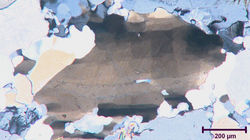
Scientific Interests
Throughout my research background, I have been interested in using evidence from mineral compositions and small-scale textural features in metamorphic rocks to understand the large-scale tectonic histories of orogenic systems. Garnet, for example, is an incredibly interesting mineral for this kind of research. Because it has a widely varying composition and often incorporates trace elements, garnet captures compositional changes during metamorphism. These compositional changes may reflect the bulk chemistry of the rock or specific reactions with other minerals such as biotite or monazite. We can also use thermobarometry to determine conditions of metamorphism and date the garnet with Sm/Nd geochronology. By combining these analyses, we can begin to piece together the history of events that the rock experienced. This can be complemented by using geochronology to date radioactive minerals such as zircon, monazite, and xenotime and relating these ages to the garnets by examining their positions relative to fabric development and garnet growth. All of this can be brought together to describe in detail the deformational and metamorphic history of the rocks these minerals come from. This information is not only useful for the specific rock sample, but if we begin to think of things in a larger context, this kind of research can shine light on the tectonic events that shaped the regions the rocks came from. For example, if we determine through compositional analyses that a rock experienced two phases of uplift that have been separated by a significant amount of time, this suggests that there must have been either two separate methods of tectonic uplift, or reactivation of a fault, or largely changing rates of uplift. This sort of a conclusion may be tough to see at the outcrop or map scale.
In a sense, each and every mineral grain in a metamorphic rock captures a part of that rock's story. I find myself most interested in putting that story together in a way that may not be evident by only examining the rocks from a distance.
Microtextures and Compositional Images
 S-C fabric development in muscovite. |
|---|
 S, C, and C' fabrics captured in micas. |
 Feldspar sigma clast showing top to the left shear sense. |
 Quartz grain under cross-polarized light displaying chessboard extinction, indicative of high temperature (≥650°C) deformation. |
 Plagioclase grain under cross-polarized light, displaying a clear subgrain boundary (color change, left half) and bulging recrystallization (serrated grain boundary, right of center). |
 Manganese element map of a poorly-zoned garnet. |
 Thorium map of a monazite grain with a sawtooth pattern reminiscent of a skull. |
 Yttrium map of a monazite grain showing clear core, mantle, and rim domains. |
 Yttrium map of an elongate monazite grain showing a core and small mantle, as well as an asymmetrical rim. |